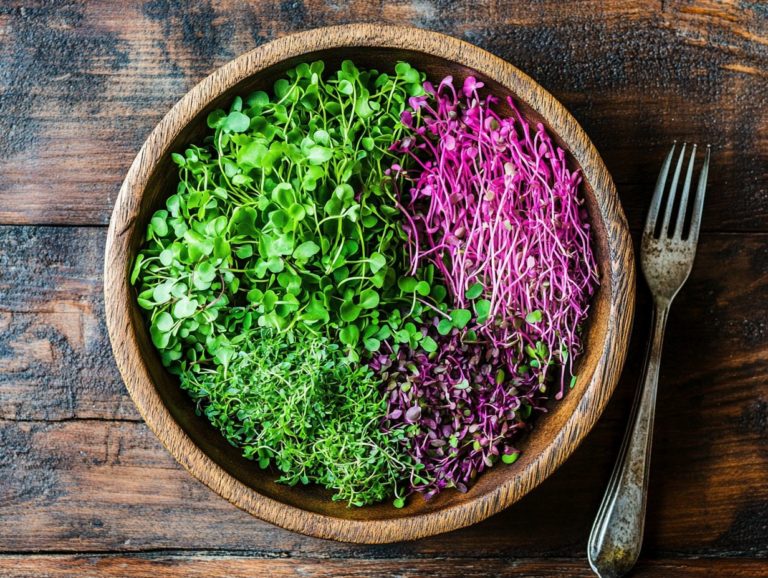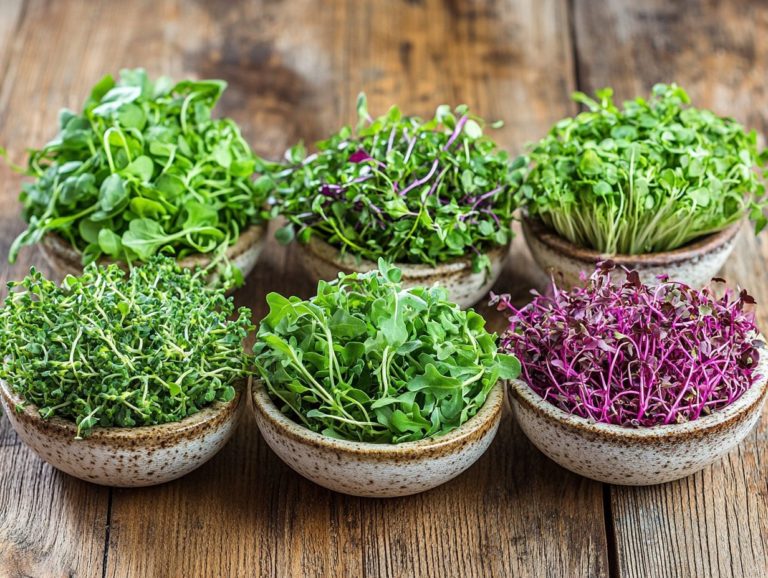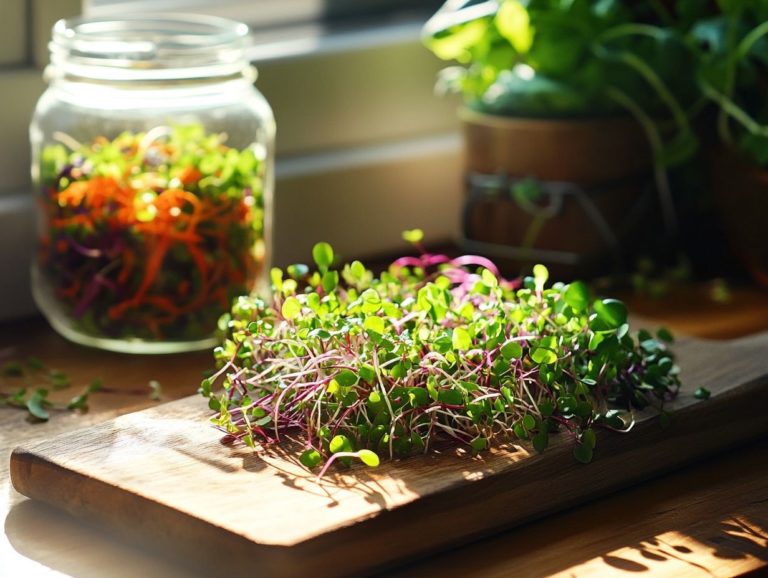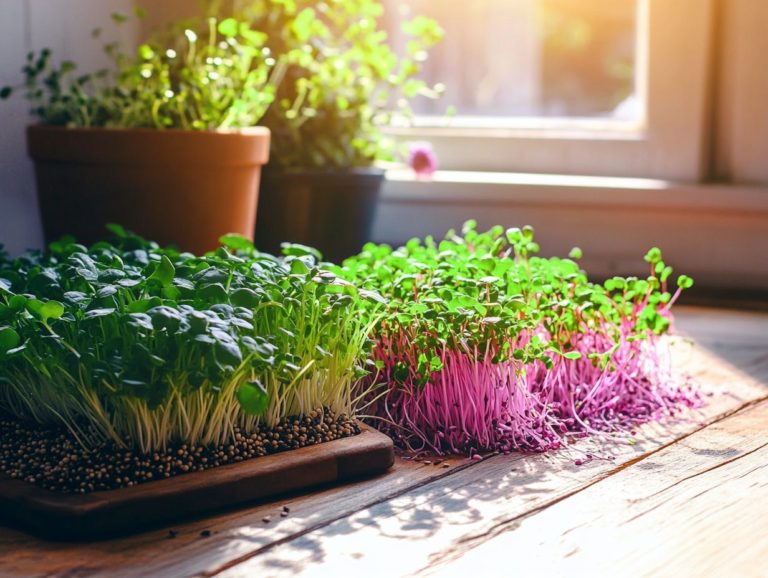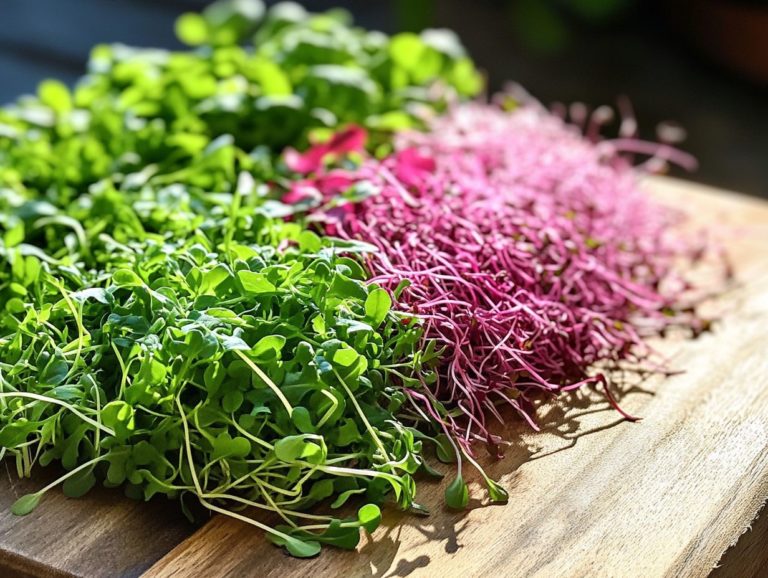5 Unique Health Benefits of Microgreens
Microgreens may be small, but they re truly powerful plants that deliver a remarkable punch in both nutrition and flavor.
Discover five unique health benefits of these vibrant greens, highlighting their impressive nutrient content and antioxidant properties. You ll find that microgreens can assist with weight management, enhance digestion, and even give your immune system a boost.
This article addresses common questions about what microgreens are, how to seamlessly incorporate them into your meals, and the best techniques for growing them at home.
Dive into the exciting world of microgreens and discover their amazing health benefits!
Contents
- Key Takeaways:
- 1. High Nutrient Content
- 2. Antioxidant Powerhouse
- 3. Helps with Weight Management
- 4. Improves Digestion
- 5. Boosts Immunity
- What Are Microgreens and How Are They Different from Sprouts?
- What Are the Different Ways to Grow Microgreens at Home?
- Are There Any Risks Associated with Consuming Microgreens?
- What Are the Other Lesser-Known Health Benefits of Microgreens?
- Frequently Asked Questions
Key Takeaways:
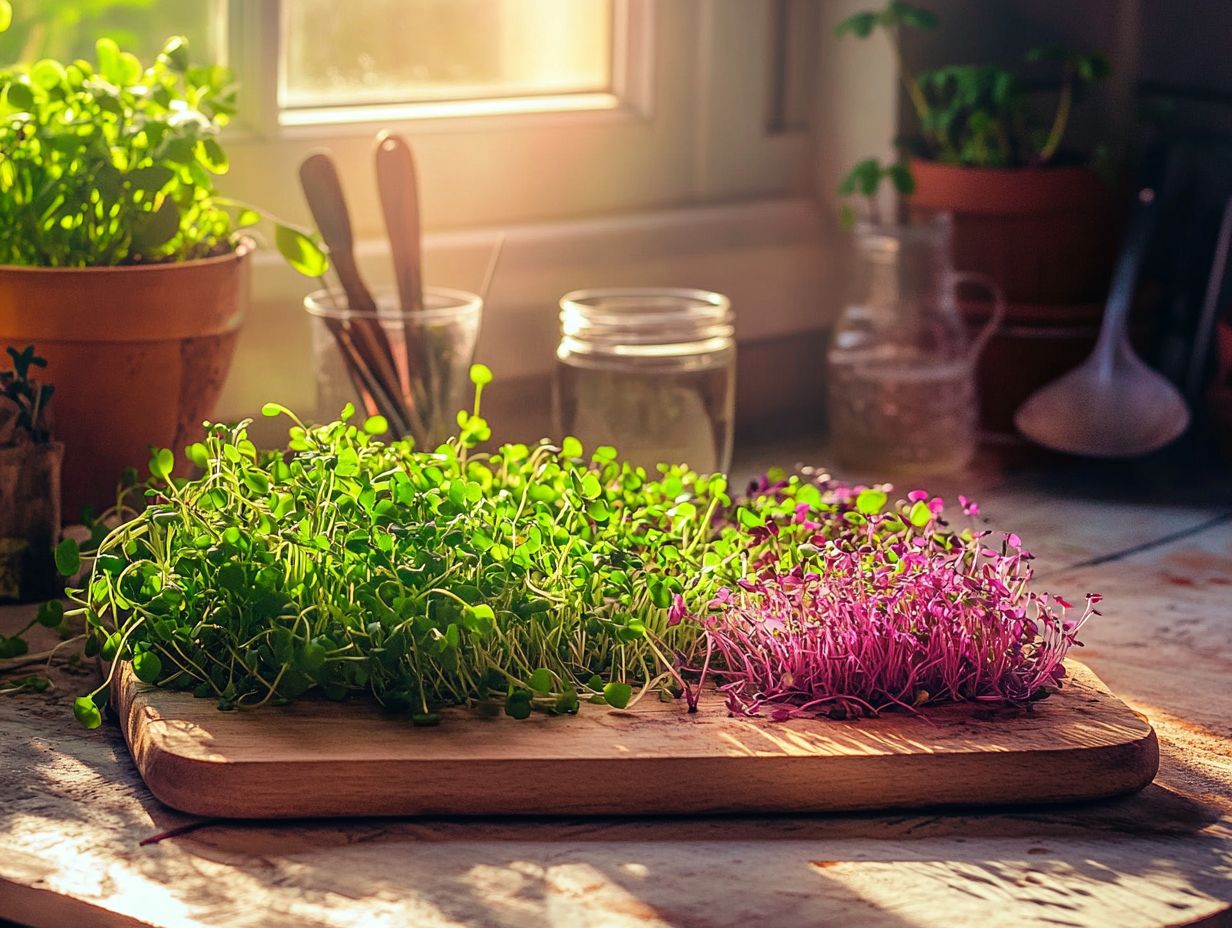
- Microgreens are a nutrient-dense food, packed with vitamins, minerals, and antioxidants that can help improve overall health and wellbeing.
- They can help reduce damage caused by free radicals and protect against chronic diseases such as heart disease and cancer.
- Adding them to meals supports weight management by providing a low-calorie, nutrient-dense addition to dishes.
1. High Nutrient Content
Microgreens are the youthful wonders of the vegetable world, brimming with an impressive array of nutrients that can significantly boost your overall health and wellbeing. Their vibrant flavors and stunning colors not only elevate your culinary experiences but also pack a serious health punch.
Research from registered dietitians highlights their exceptional nutritional benefits, especially their abundant dietary fiber, which can assist in managing health conditions like heart disease and Type 2 diabetes.
These tiny greens offer a treasure trove of vitamins A, C, E, and K, each playing a pivotal role in enhancing your immune system, improving skin health, and bolstering bone density. For instance, the vitamin C in microgreens promotes collagen production, contributing to youthful skin. Incorporating the top 5 microgreen varieties for breakfast can further boost your nutrient intake.
Vitamin K is essential for blood clotting and maintaining healthy bones. Essential minerals like iron and calcium found in varieties such as broccoli and red cabbage strengthen your body, supporting energy levels and ensuring robust bone health.
By integrating these nutrient-dense microgreens into your plant-based diet, you can unlock a myriad of health benefits, transforming simple meals into nourishing powerhouses.
2. Antioxidant Powerhouse
Microgreens are an outstanding source of antioxidants, known for their ability to combat oxidative stress damage caused by free radicals in your body. They play a vital role in cancer prevention, heart disease management, and overall health benefits.
With a rich antioxidant profile that includes compounds like polyphenols and glucosinolates, they are an essential addition to your balanced diet. Among the popular varieties, fenugreek microgreens shine with their high levels of saponins, which help reduce cholesterol and enhance fat metabolism.
Radish microgreens, on the other hand, are packed with sulforaphane, excelling at activating detoxification enzymes that protect your cells from damage. Research suggests that regularly incorporating these microgreens into your meals could lower your risk of chronic conditions like diabetes and hypertension.
Incorporating these nutritional powerhouses into your daily meals is a breeze. They can elevate salads, enhance smoothies, or serve as flavorful toppings on sandwiches. By simply adding a handful of microgreens to various dishes, you can effortlessly boost your antioxidant intake and overall health.
3. Helps with Weight Management
Adding microgreens to your meals can greatly help you manage your weight. These tiny greens pack a big punch for your health, thanks to their low-calorie count and high dietary fiber content.
They are perfect for anyone aiming to maintain a healthy weight or manage conditions like Type 2 diabetes. The fiber they provide promotes a sense of fullness, helping you reduce overall calorie intake while still delivering essential nutrients.
These tiny greens are brimming with vitamins and minerals, contributing to your overall health. Imagine tossing them into salads, smoothies, and wraps!
- Salads
- Smoothies
- As a vibrant topping on sandwiches and wraps
You can also throw them into omelets or grain bowls for an extra nutritional boost. Snacking on microgreens paired with hummus or guacamole offers a satisfying crunch, making them an ideal solution for anyone looking to achieve better weight management and maintain stable blood sugar levels.
4. Improves Digestion
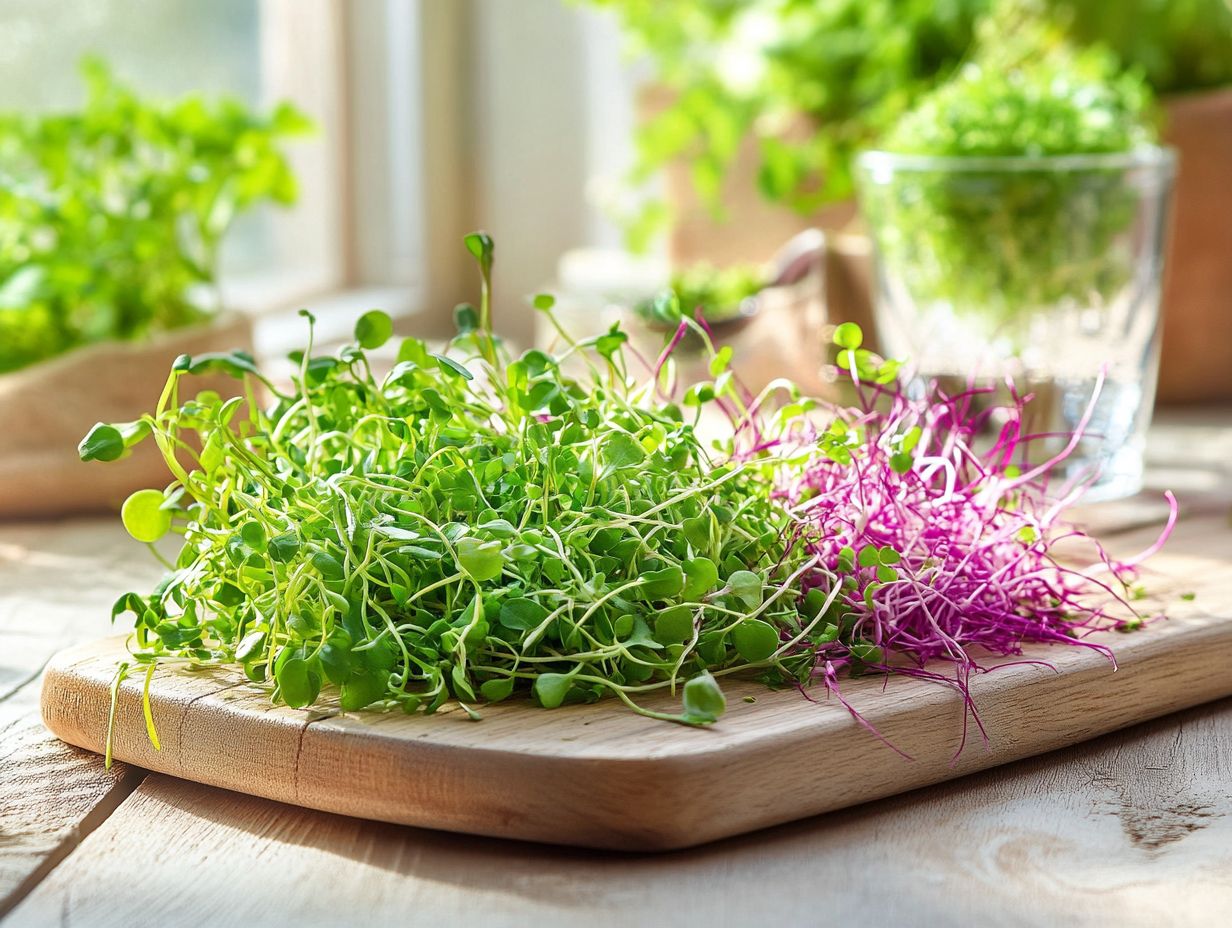
Microgreens can transform your digestion for the better! Thanks to their impressive fiber content, they promote gut health and can alleviate various digestive issues.
By incorporating these vibrant young vegetables into your meals, you’re not just adding flavor and nutrition; you’re actively supporting a healthy digestive tract and encouraging regular bowel movements.
These nutrient-rich foods significantly contribute to your overall wellness. Take spinach and broccoli microgreens, for instance these are particularly renowned for their high fiber levels, making them a fantastic addition to a balanced diet and improved gut function.
To maximize the benefits of these nutritious gems, consider:
- Tossing fresh microgreens into your salads,
- Blending them into smoothies for that extra nutrient kick, or
- Adding them to wraps and sandwiches.
They don’t just elevate the taste and texture of your meals; they also play a vital role in maintaining your digestive health. Exploring unique microgreen varieties can ensure your body operates at its peak performance.
5. Boosts Immunity
Microgreens are incredible for boosting your immune system! They are brimming with vitamins and antioxidants that empower your body to fend off illnesses and enhance its immune response.
Their impressive nutrient profile is essential for maintaining optimal health, particularly during the cold and flu seasons.
These petite powerhouses are especially abundant in vitamin C, which is renowned for its capability to bolster the immune system by encouraging the production of white blood cells. What’s more, they are rich in beta-carotene, a precursor to vitamin A, which supports the maintenance of mucosal membranes, acting as a crucial barrier against pathogens.
By regularly incorporating microgreens into your meals, you establish a robust foundation of essential nutrients that fortify your body in its battle against infections, promoting overall wellness. This vibrant addition not only elevates your diet but also offers a delectable means to safeguard your health.
Ready to boost your health? Start adding microgreens to your meals today!
What Are Microgreens and How Are They Different from Sprouts?
Microgreens are the young vegetables you harvest just after their first true leaves have emerged. This sets them apart from sprouts, which are germinated seeds often enjoyed at an even earlier stage. While both are nutrient-dense and brimming with health benefits, microgreens tend to offer a more robust flavor and boast higher concentrations of vitamins, minerals, and antioxidants. This makes them the go-to choice for culinary enthusiasts and health-conscious eaters alike.
To thrive, microgreens flourish in controlled environments with soil or suitable growing mediums. They require light to achieve their optimal growth. In contrast, sprouts can be effortlessly cultivated in water, often using jars or trays, without any soil at all.
This fundamental difference gives rise to unique flavor profiles. Popular microgreens such as radish or basil present strong, distinctive tastes that can truly elevate your salads and sandwiches. Meanwhile, sprouts like alfalfa or mung bean provide a milder flavor and a delightful crunch, perfect for topping soups or grain bowls.
Microgreens are more than just tasty; they’re a powerhouse of nutrition! Some varieties pack several times the nutrients of their mature counterparts, enhancing the overall health benefits of your meals. Learning about the benefits of growing diverse microgreen varieties can further elevate your culinary experience.
What Are the Most Nutritious Microgreens?
Among the most nutritious microgreens you can incorporate into your diet are those from a group of vegetables that includes broccoli, red cabbage, and kale. These little powerhouses are celebrated for their impressive levels of vitamins, minerals, and health benefits that support your overall wellness. You’ll particularly appreciate their potential cancer-fighting properties and antioxidant content.
But don’t stop there; explore other beneficial varieties like arugula, beet greens, and sunflower microgreens. They offer a treasure trove of nutrients to elevate your health. For instance, arugula shines with its high vitamin K and calcium content, promoting bone health and reducing inflammation. Additionally, you can learn about the top microgreen varieties for health enthusiasts to further boost your wellness journey.
Beet greens are rich in iron and support detoxification, while sunflower microgreens are loaded with essential fatty acids and protein. This makes them an ideal choice for anyone eager to enhance their nutrient intake.
By simply including these vibrant greens in your daily meals, you can effortlessly boost your overall nourishment. This paves the way for improved health and vitality.
How Can Microgreens Be Incorporated into Meals?
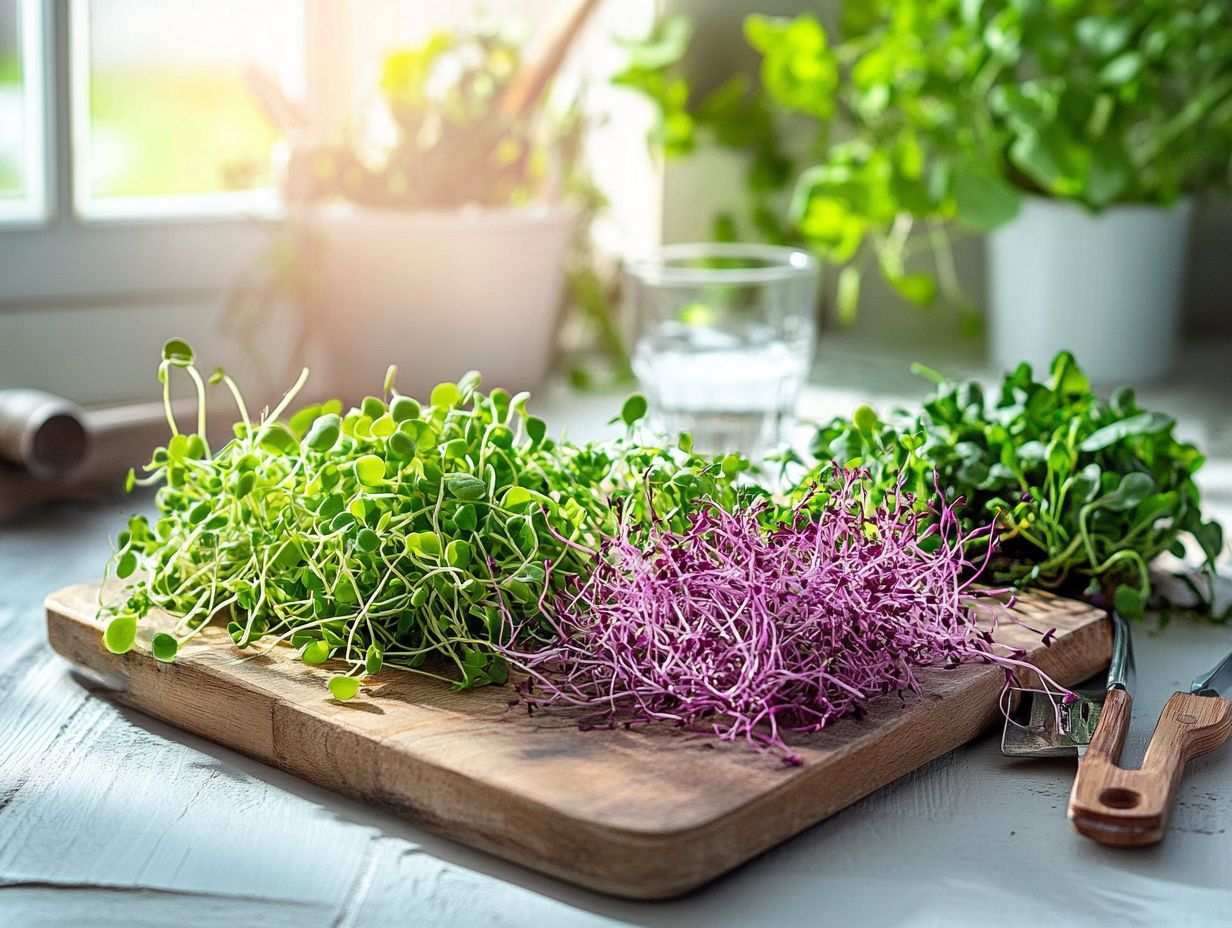
You can effortlessly weave microgreens into your meals, elevating both nutrition and flavor when enjoyed raw or lightly cooked. They serve as a vibrant garnish, a fresh addition to salads, or a delightful topping for sandwiches and wraps, allowing you to savor their health benefits with ease.
These tiny powerhouses can be blended into your smoothies for an instant nutrient boost or folded into omelets and frittatas for breakfast. Pair them with hearty grains like quinoa or brown rice for a satisfying lunch.
Sprinkle them atop roasted vegetables for a flavorful dinner. To truly maximize their nutritional impact, consider combining microgreens with healthy fats, such as avocado or olive oil, which help with the absorption of vitamins that dissolve in fat and are better absorbed when eaten with healthy fats.
Don t hesitate to experiment with different microgreen varieties, like arugula or radish, to introduce exciting flavors and textures to your favorite dishes.
What Are the Different Ways to Grow Microgreens at Home?
Growing microgreens at home is a delightful and simple endeavor. It’s an ideal way to enhance your diet with fresh, nutrient-rich vegetables right from your kitchen. You can choose between soil, hydroponics (a method of growing plants without soil), or a simple growing tray. Each method empowers you to reap the health benefits and nutritional advantages of these vibrant greens.
With just a few essential materials seeds, a growing medium, and a light source you can embark on this rewarding culinary journey. First, select the right seeds, such as arugula, radish, or basil, all of which thrive in the microgreen environment.
Next, choose a suitable container. Whether it s a shallow tray, a repurposed clamshell, or a dedicated microgreens kit, this choice lays the foundation for your success.
Once you moisten the medium, sprinkle the seeds evenly and cover them lightly. Place them in a well-lit area or under grow lights. The real magic happens within a week or two, as you harvest freshly grown greens that elevate your meals and enrich your diet with essential vitamins and minerals.
Are There Any Risks Associated with Consuming Microgreens?
While microgreens are generally safe and packed with nutrition, some health risks are associated with consuming them raw especially foodborne illnesses that can result from improper handling or contamination. It s crucial to follow safe food practices to minimize these risks and ensure a healthy experience.
These little greens, known for their vibrant flavor and concentrated nutrients, can harbor harmful bacteria like E. coli or Salmonella if not washed properly or if sourced from unreliable growers. Rinse them thoroughly under cold running water, even if they appear clean.
If you’re considering buying them from local stores, look for reputable suppliers or certified organic farms, as they typically follow stricter safety regulations. Growing microgreens at home can be rewarding, but start with high-quality seeds and maintain clean, sanitized growing conditions to reduce risks associated with raw consumption.
What Are the Other Lesser-Known Health Benefits of Microgreens?
Beyond their widely recognized nutritional benefits, microgreens offer a treasure trove of lesser-known health advantages. These tiny greens boast impressive anti-inflammatory properties, enhance skin health, and support detoxification due to their abundant nutrients and antioxidants.
Research shows these miniature powerhouses may also help reduce the risk of chronic diseases, strengthen your immune system, and support optimal gut health. A 2018 study published in the Journal of Agricultural and Food Chemistry revealed that the antioxidant content in microgreens often surpasses that of mature vegetables, making them a powerful addition to your diet. Incorporating the top 5 microgreens for smoothies can further enhance your health benefits.
Incorporating microgreens into your meals can enhance not only your nutritional intake but also the flavor profile, encouraging you to adopt healthier eating habits. By weaving these small greens into your daily routine, you can embrace a more holistic approach to wellness and discover microgreen varieties and their health benefits, seamlessly aligning your nutrition with your vitality.
Frequently Asked Questions
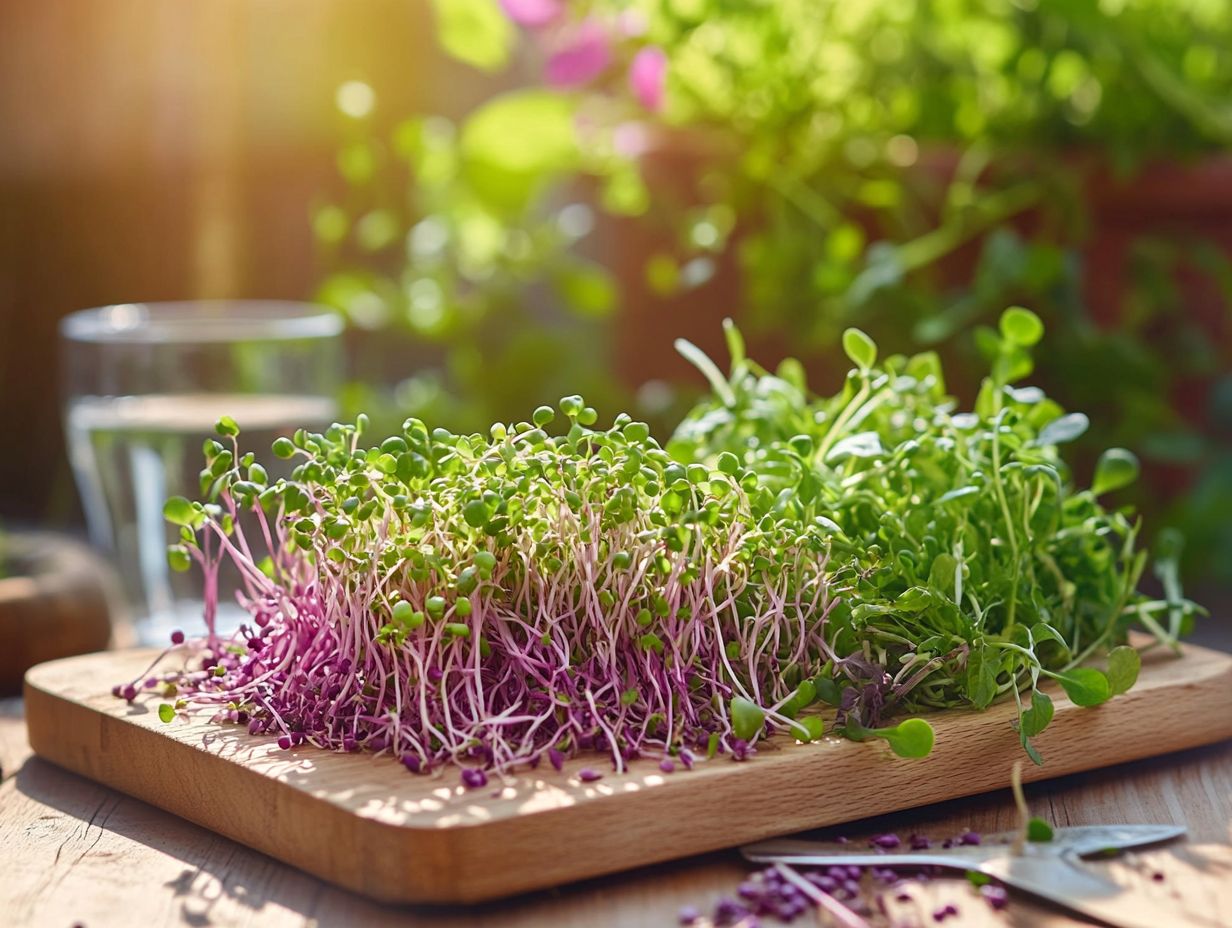
What are microgreens?
Microgreens are young, tender, and edible seedlings of various vegetables, herbs, and flowers. They are harvested when they are about 1-3 inches tall, packed with nutrients, and have a concentrated flavor, making them popular for garnishes and in salads, soups, and sandwiches.
Why should I include microgreens in my diet?
Microgreens are known for their high nutrient content and various health benefits. They are rich in vitamins, minerals, antioxidants, and enzymes that support a healthy body and boost immunity.
Start growing your own microgreens today for a healthier you!
What are the top 5 unique health benefits of microgreens?
1. High in Nutrients: Microgreens contain more nutrients than their mature counterparts. They are especially rich in vitamins C, E, and K, as well as minerals like iron, magnesium, and potassium.
2. Powerful Antioxidants: These tiny greens are packed with antioxidants. They help fight free radicals, reduce inflammation, and protect against chronic diseases.
3. Improves Digestion: Microgreens are a good source of fiber, which promotes healthy digestion. This can prevent constipation and other digestive issues.
4. Boosts Immunity: The high nutrient and antioxidant content in microgreens strengthens your immune system. This makes you less susceptible to illnesses.
5. Lower Risk of Chronic Diseases: Eating microgreens regularly is linked to a lower risk of chronic diseases like heart disease, diabetes, and some cancers.
Can microgreens help with weight loss?
Yes, microgreens are low in calories but high in nutrients. They help control cravings and keep you feeling full longer, making it easier to maintain a healthy diet.
Are there any specific types of microgreens that offer additional health benefits?
Yes, certain types of microgreens offer extra health benefits. For instance, broccoli microgreens are high in a compound that may help prevent cancer. Radish microgreens are rich in vitamin B6, which can help regulate metabolism and boost your mood. Fenugreek microgreens can lower cholesterol levels and improve blood sugar control.
How can I incorporate microgreens into my meals?
Microgreens are easy to add to meals. Use them as toppings on sandwiches, soups, or salads. Blend them into smoothies or use them as garnishes. Get creative and try new recipes to enjoy the benefits of microgreens!
Try adding them to your favorite meals today!

